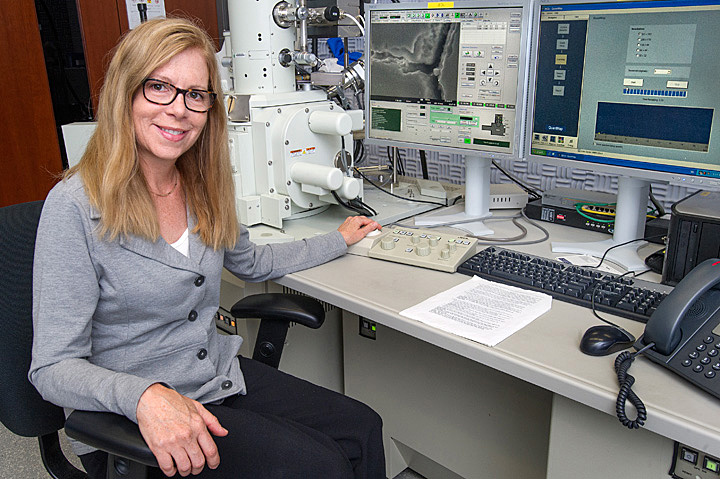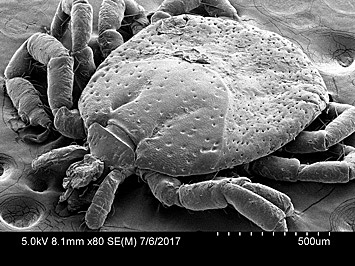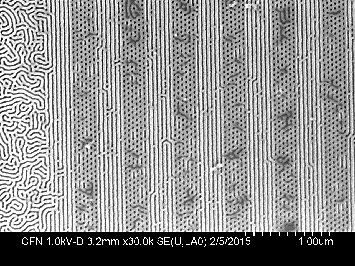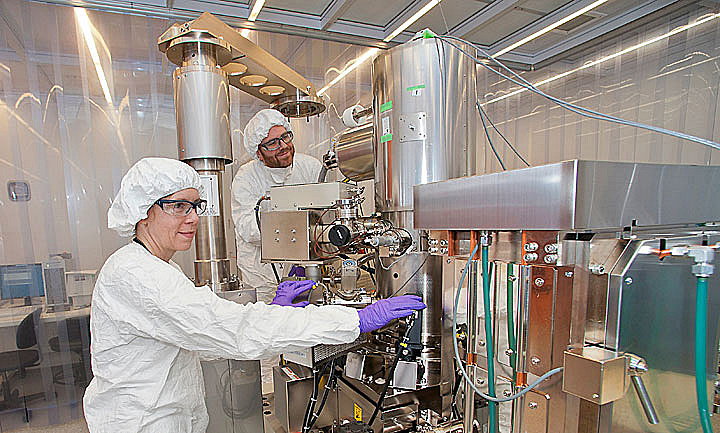10 Questions with Gwen Wright
interview with a CFN staff member
August 1, 2017
 enlarge
enlarge
Gwen Wright in the scanning electron microscope (SEM) lab at CFN, where she trains users and staff members on how to operate the SEMs. In addition, Wright provides safety and instrument training for the CFN cleanroom.
What brought you to the CFN?
Before coming to CFN, I was working in different cleanrooms at the IBM Thomas J. Watson Research Center in Westchester County, New York. It was there that I gained experience with etching, lithography, and various other tools to make things like memory chips. During my 32 years at IBM, I met Chuck Black, who ended up leaving IBM to lead the CFN Electronic Nanomaterials Group. Chuck spoke highly of CFN. I also knew Jim Misewich—now the Associate Laboratory Director for Energy and Photon Sciences at Brookhaven—from his IBM days.
One day, I happened to see a job opening for a cleanroom staff member at CFN. The job to oversee some of the cleanroom users and tools sounded like a perfect fit—it aligned with my areas of expertise. Even though Brookhaven Lab is about 90 miles from where I was living at the time, I decided to give it a try. I am very glad I did!
You have a background in engineering and communications. Has that dual science and humanities perspective come in handy during your career?
When I started undergrad, I was a ballet student. Then I switched my major to biology. I again switched majors—for the final time—when I joined the university's radio station because of my interest in communications. But I realized I liked the engineering side of radio way more than anything else. I went on to complete some graduate work in the field.
Early in my career, I found that I had an advantage over fellow engineers when it came to writing papers. I took a lot more English and some foreign language courses that I would not have had the opportunity to take with the engineering path alone.
However, when it comes to communicating what safety issues to be aware of and how to operate the tools, I learned a lot on the job. Even when there is a language barrier—which there often is—I can overcome it through trial and error. Yes, I am teaching people whose first language may not be English, but they do have a technical background where we can find common ground. Walking someone through the cleanroom and talking about chemical safety is definitely harder than showing them how to use a particular piece of instrumentation, which is much more visual and hands-on.
What is the process for gaining access to the cleanroom?
Before anyone is allowed in the cleanroom, safety training, especially in the area of chemical safety, is required. This training includes a comprehensive safety video and a few hours' worth of online courses with information to read and answer questions about—for example, what to do with chemical waste or what to be aware of when working with nanoparticles.
Once I confirm that training has been completed, I give a walkthrough for about an hour. Some people have never worked in a cleanroom before so I go over what a cleanroom actually is in addition to showing them around. Chemical safety is heavily stressed during each walkthrough. I explain and demonstrate how to safely work with chemicals and use the safety shower in the case of a spill. I also explain the protocols in place to prevent particulates (airborne solid and liquid particles) from being introduced into the cleanroom and causing contamination. Anyone who enters the cleanroom needs to wear a special head-to-toe garment—commonly called a "bunny suit"—designed to trap contaminants generated by regular clothing and the body, such as lint, fibers, skin flakes, hair, and oil. This gowning process can take some time getting used to. Prohibited items include chewing gum, water bottles, and regular paper (there is specially formulated cleanroom paper that minimizes particulates).
 enlarge
enlarge
A scanning electron microscope (SEM) image of a tick that Gwen Wright pulled off herself one morning. The user Wright was training on the SEM at the time did not have his own sample to look at, so she used the tick sample instead.
Access to the tools expires after a period of non-use that is determined based on the guidelines set by the tool owner and observations made by me and the other cleanroom staff members. The easiest-to-use scanning electron microscope (SEM) is set at one year. To re-authorize access, users need to speak with me and see if a refresher training is necessary. Users who have not been at CFN for some time but continue to use the same tools at their school, for instance, may not need the training upon returning.
Every week, there are approximately two or three new people in the cleanroom, though during the summer—our busiest time of year—there can be more. At any given time, I am probably training two or three people on each tool.
Which tools are you responsible for training users and staff members on, and how do the tools compare in terms of ease of use?
I am responsible for training on two electron-beam evaporators and two SEMs. In electron-beam evaporation, an electron beam strikes a material and vaporizes it under vacuum conditions. The vapor then condenses and forms a thin film or coating on the surface of a substrate. This physical vapor deposition technique is commonly used to deposit metals onto substrates—for example, silicon thin films evaporated on plastic substrates for solar cell applications. The SEMs produce high-resolution images of samples by scanning a sample's surface with a focused electron beam under vacuum conditions. The electrons interact with the atoms that make up the sample to generate signals containing information about the sample's structure and chemical composition.
For the e-beam evaporators, after the samples are loaded, it takes a few hours to pump down the pressure in the vacuum chamber to reach the appropriate deposition pressure. So while the actual training part may be an hour, the waiting period between sample loading and deposition extends this time. Our e-beam evaporators also run in highly manual modes so users must really understand the process to operate them. I try to work it out such that I wait to train users until they are at the point in their projects when they are ready to use the instrument.
The SEMs are tools that take some time to get really good at. Looking at a sample just to check it may be doable for a novice but to save decent high-resolution images may require some tweaking of the electron optics that requires my help. For example, the electron-beam column must be properly aligned to ensure that everything is well focused. In addition, the optimal operating conditions (e.g., voltage, beam current) are different for every sample.
Have there been any incidents in the cleanroom since you started at CFN, and, if so, how did the incident(s) inform safety training going forward?
A few years ago, there was an incident in which isopropyl alcohol was accidentally mixed with piranha etch (a mixture of sulfuric acid and hydrogen peroxide), causing a reaction that broke the container. We were fortunate that nobody was nearby when it happened, and so no one was injured. The lab was closed for several weeks, and I worked with the other three cleanroom staff members and Brookhaven Lab management on a plan to prevent the accidental mixing of incompatible chemicals in order to stop this type of incident from happening again. We continue to stress the importance of safety and encourage a culture of asking questions when conducting scientific research.\
Besides safety and equipment training, are you involved in any other efforts at CFN?
 enlarge
enlarge
Gwen Wright uses electron-beam lithography to generate patterned templates that drive the self-assembly of block copolymers (blocks of different polymer segments in one polymer) in precisely controllable ways. This scanning electron microscope image shows the different molecular patterns—in this case, parallel lines and dots—that can coexist within a single nanostructure in specific arrangements. The ability to direct the self-assembly of materials into complex nanostructures could enable advances in microelectronics, sensing, and other applications.

Gwen Wright and Aaron Stein at the electron-beam lithography writer in CFN's cleanroom.
I also am in charge of ordering supplies for the lab, everything from petri dishes and beakers to bunny suits and chemicals. Almost every day there is something that needs ordering. Filling the liquid nitrogen tanks is usually a daily order. I try to order supplies in advance because it could be weeks or months before they are delivered, but we do not have a lot of storage space. We cannot have too many chemicals in storage at once, especially the acids. It is amazing how much we go through!
Your work puts you in close contact with the CFN user community. What has that experience been like, and what have you learned along the way?
At IBM, I spent a lot of my time working alone in a lab. At CFN, it is the complete opposite. I am always interacting with people. Many of our users are in their mid to late twenties—the same age as my two sons, both of whom are engineers. So I feel very at ease and comfortable around the users, and can relate to them. I try to make the users feel the same way, not only in the cleanroom but also in their lives. Our users come from all over the world, and adapting to new surroundings and a new culture can be overwhelming for them. I try to help them get acquainted with the area, such as by letting them know where they can go to eat. I also try to make it very clear that it is my job to help, as people often apologize for "bothering" me.
I learn a little bit from everyone along the way, on both personal and professional levels. As I mentioned, our user community is international, so I get firsthand glimpses into different places all throughout the world. Especially if users have conducted research in a cleanroom before, they often share with me what has worked best in their experience—for example, whether it is better to use thermal evaporation over electron-beam evaporation to deposit gold films.
In training people on the SEMs, I get to see the very beautiful structures—carbon nanotubes, acid deposited on heated gold, chards of perovskite, lithium dendrites, pyrolytic graphite bombarded with argon gas ions—they are working on. Every year, the CFN has a photo contest in which everyone votes on the best image depicting life at CFN and the best technical image. The winning photos are framed and displayed on a wall inside CFN, and the runner-up photos are featured in a calendar that gets distributed to the CFN community.
From your perspective, what could be done to improve the user experience?
I am working with fellow safety colleagues to streamline the online training modules. Right now, many of the modules repeat information. For instance, our module on how to safely handle cryogenic liquid says that you always have to wear long pants and closed shoes in any CFN lab but so does the lab overview module. The three other staff members—Aaron Stein, Fernando Camino and Ming Lu—and I also meet on a monthly basis and are in touch all the time (our offices are in the same hallway) to discuss how we can improve the safety and equipment training experience.
For problems we may not be aware of, we rely on an anonymous user satisfaction survey that is conducted on an annual basis. If users are not satisfied with a particular area—say, user support—we try to figure out what is causing this dissatisfaction and remedy it. We want our users to leave CFN having had a really good experience and leave the door open for them to come back with another project.
One area that we are always trying to improve is reducing the amount of downtime that users encounter for each tool and making users aware of that downtime before they make an unnecessary trip. When we have scheduled maintenance on a particular tool, we send out an email alerting all of the users of that tool. When a user reports that a tool is down, I check to see if the problem is something I can fix myself. For example, rebooting the computer for the SEMs often fixes things. Another common thing that happens with the SEMs is that the sample falls off the rod used to push the sample onto the stage and falls to the bottom of the sample chamber—something I can fix. If the tool is broken in the morning and requires a service call, I try to get in touch with users scheduled for that day so they know not to come.
In your opinion, what makes CFN so special?
There is a very supportive environment at CFN. I have the sense of being part of a well-functioning and dedicated team. I can always count on the help of my coworkers.
What is the most rewarding part of your work?
Getting to see the impact of my help. When users have never used an SEM before and they put in the sample of what they made, focusing it and seeing it for the first time, I definitely feel like I have helped. Knowing that I am helping the next generation of scientists to achieve great things is very rewarding.
2017-12398 | INT/EXT | Newsroom









